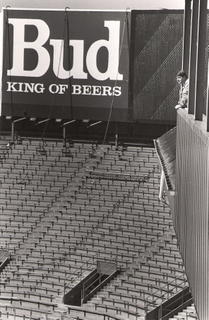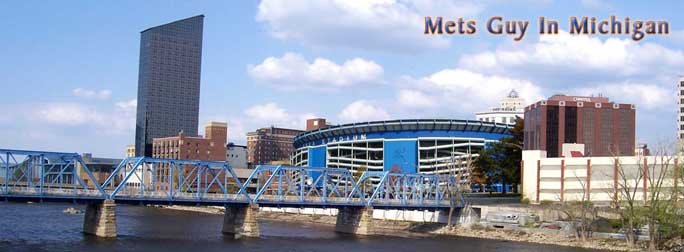
The grass in a Major League stadium is a brilliant green on Opening Day, radiant compared the the still-brown lawns in our Midwestern cities.
Of course, the stadiums have an advantage. They paint the grass.
I didn't know this -- and probably wouldn't have believed it -- until I saw it for myself.
My birthday is in the first week in April, and sometimes falls on Opening Day, which my family says is appropriate. But my birthday came in 1991 and I remember going through a rough stretch at work and being in a foul mood.
Then my colleague and buddy, John Munson, arrived with one of the best birthday presents ever. John was a photographer at the Flint Jounral and we often worked together. He convinced the editors that what we really needed was a story about how workers get Tiger Stadium ready for Opening Day, and how I should tag along to supply the words for his photos.
The editors signed off, and what an awesome day we had.
We had lived in Michigan just over a year at that point, and had been to Tiger Stadium many times. It was a wonderful old stadium, full of little oddities -- and some big ones, too. And I was thrilled to get a chance to see things going on behind the scenes, stuff fans don't typically get to experience.
We arrived around mid-morning, picked up our credentials and were excited to see that we had complete run of the stadium.
The Tigers' opening series with the Yankees was still a couple days away, but the stadium was bustling with activity. We went out to the field first, following the loud noise coming from centerfield. Out in the middle was a crew covered in green spraying what appeard to be paint on the grass. I was stunned. It was one of those "pull-the-beard-off-Santa Claus" moments. We walked on the crushed gravel warning track to centerfield, touched the base of the famous in-play flagpole -- because we could -- and chatted with the crew members. The explained that the "paint" was a mixture of fertilizer and food coloring, enough to keep the grass looking great in April and May.

We then poked around the dugouts, which are really cramped, and walked up the narrow tunnel that leads to the clubhouse. There's a small sink in the tunnel, just deep enough in so that it can't be seen from the stands. Goodness knows what the players do to or in it.
We checked out the Tigers clubhouse first. Workers were installing new blue carpet and tiger-striped wallpaper in Sparky Anderson's office. Player lockers are not like lockers you see in schools. There are no doors, just spots along the wall separated by something that looked like a small chain-link fence. Director chairs with the team's Old English D logo were on top of each locker, I assume because of the carpet work. Boxes of new batting helmets were arriving. We tried them on because, again, we could!
We then ventured into the trainer's room, which is off-limits to reporters during the season. Tiger pitching legend Jack Morris had left the team for the Twins during the winter, and Morris had written a personal note to the trainers and taped it to the wall for them to see when they came north with the team. It was neat because Morris had a reputation of being very grumpy, so it was nice to see another side of him.
The visitors clubhouse was really spectacular. The walls are covered in white ceramic tiles like you'd see in a bathroom, expect players through the years had augraphed them. The guys fixing cracked tiles told us they spent a couple hours walking around the room reading the walls.
We then moved into the bullpens, which are cages sunken into the ground. The view is horrible -- probably the worst seat in the house -- and it's got to be hot in there during the summer months. It's also so deep that players need a little wooden staircase to get in and out, and that wasn't yet in place when I jumped in, so it was a little tough getting out.
We later walked around the press boxes and boxes that run along the roof of the stadium that must have been used when the Lions used the stadium, too. They ran all the way along the top into rightfield. There wasn't much inside, just something that looked like a running shelf or desk where you would set a drink or laptop on. There were no seats or anything, and it was nothing like the luxury boxes I've seen in other stadiums. Unlike the bullpen, the view was awesome. I was higher than any seat in the stadium, and still closer to the action than anything in New Comiskey Park's upper deck. We opened another door and ended up on the actual roof of the stadium.
It was fun talking to the workers, who seemed to have an appreciation for the historic building they were working in. I remember one of the guys in the visitors clubhouse pointing his chisel around the room listing players who must have passed through at one point.

We also spent time with the man responsible for painting the logos on top of the dugouts. It's a tougher job than you think because the Tigers logo at the time was pretty complicated and there weren't stencils. And unlike some stadiums that have pre-painted boards attached to the top of the dugouts, this man was painting these logos right on the roof. He said it took about two days of kneeling on concrete to get the job done each year. But it was a point of pride for the artist, a sign-maker from Troy. He had done it since 1985 and loved to come back to the park during the year and inspect his handiwork.
Tiger Stadium was open another nine years after that, and each time I returned I'd look to the boxes on the roof, the sunken bullpens and the brilliant green field and think of that birthday.


No comments:
Post a Comment